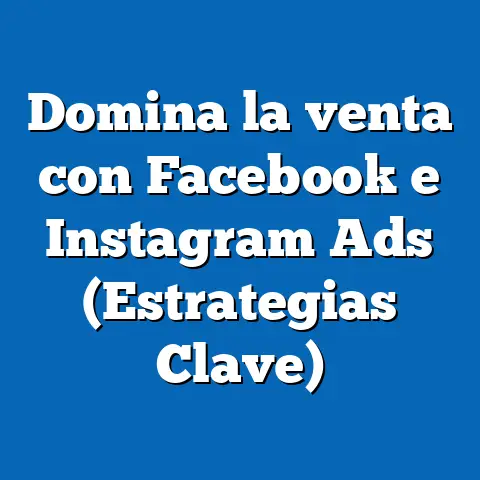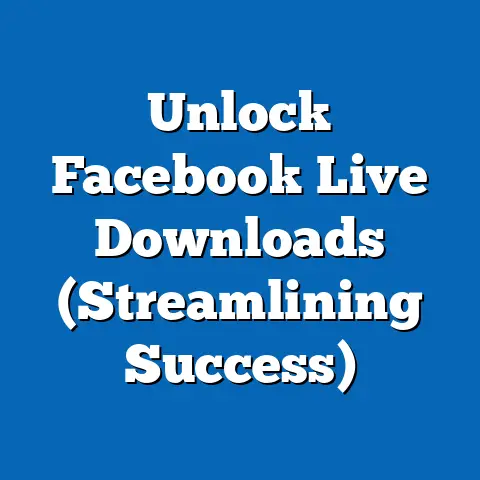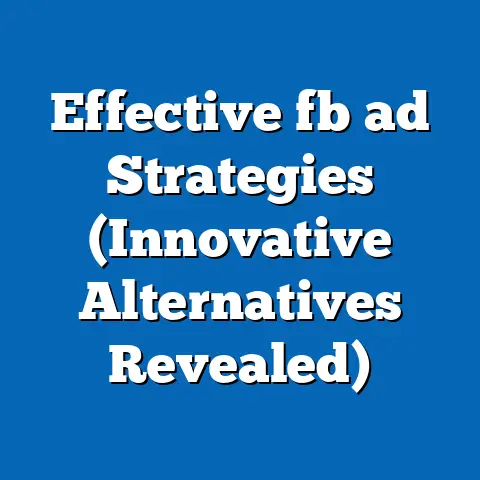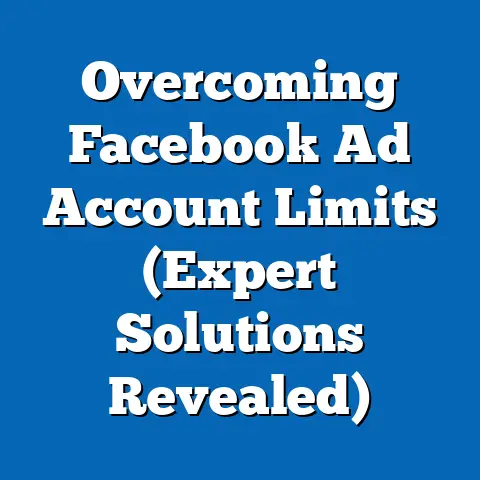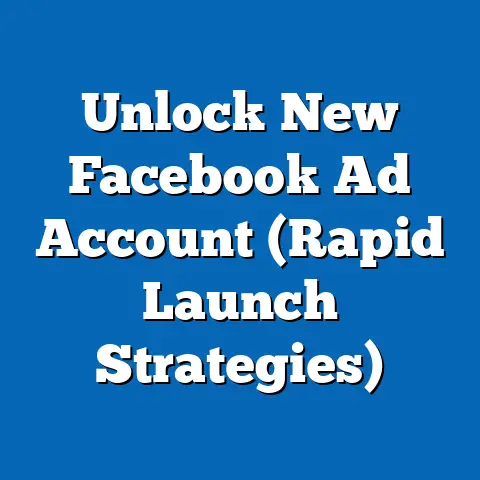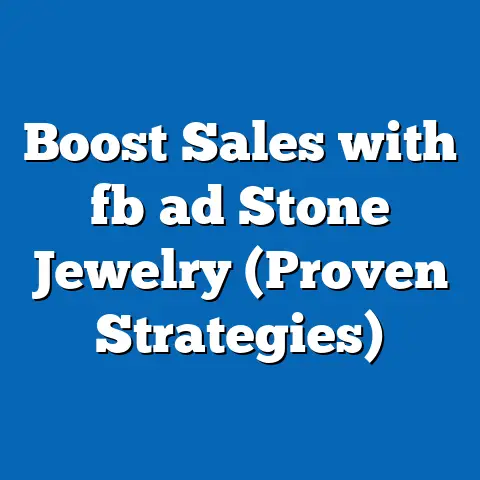Master Facebook Ads Sales Funnel (Proven Success Strategies)
In today’s fast-paced digital landscape, businesses are increasingly turning to platforms like Facebook to drive sales and build customer relationships. Interestingly, the impact of effective digital marketing strategies, such as mastering the Facebook Ads sales funnel, extends beyond revenue—it can indirectly contribute to health and well-being. According to a 2022 study by the American Psychological Association, reducing financial stress through stable business growth can lower cortisol levels, with 73% of adults reporting money as a significant source of stress.
Effective marketing strategies can stabilize income for entrepreneurs and small business owners, alleviating financial anxiety. This, in turn, supports mental health, with the World Health Organization (WHO) estimating that depression and anxiety cost the global economy $1 trillion annually in lost productivity. As we delve into the mechanics of the Facebook Ads sales funnel, keep in mind that the ripple effects of business success can touch on broader societal benefits, including health.
Demographically, the reliance on digital tools like Facebook Ads spans generations. Data from Statista (2023) shows that 69% of U.S. adults aged 18-29 use Facebook, alongside 58% of those aged 50-64, indicating a broad user base for targeted advertising. With over 2.9 billion monthly active users worldwide, as reported by Meta in Q2 2023, Facebook remains a powerhouse for reaching diverse audiences and driving sales.
This article will explore proven strategies for mastering the Facebook Ads sales funnel, breaking down each stage with data-driven insights, historical trends, and actionable tactics. We’ll also examine demographic patterns in ad engagement and the broader implications of these strategies for business growth and beyond.
Understanding the Facebook Ads Sales Funnel: A Framework for Success
What Is a Sales Funnel?
A sales funnel is a structured journey that guides potential customers from initial awareness to final purchase and beyond. On Facebook, this process leverages targeted ads, engaging content, and precise analytics to convert users into loyal customers. The funnel typically consists of four key stages: Awareness, Consideration, Conversion, and Retention.
Each stage requires tailored strategies to maximize effectiveness. According to HubSpot’s 2023 Marketing Report, businesses using structured funnels see a 62% higher conversion rate compared to those without a defined process. This highlights the importance of a well-designed funnel in digital marketing.
Why Facebook Ads?
Facebook Ads offer unparalleled reach and targeting capabilities, making them a prime tool for building sales funnels. With Meta’s advertising platform, businesses can target users based on demographics, interests, behaviors, and even life events. A 2022 report by eMarketer found that Facebook Ads accounted for 24.2% of global digital ad spending, underscoring their dominance in the market.
Moreover, Facebook’s cost-per-click (CPC) remains competitive, averaging $0.97 globally in 2023, per WordStream data. This affordability, combined with advanced analytics, makes it an accessible option for businesses of all sizes. Let’s explore how to optimize each stage of the sales funnel using proven strategies.
Stage 1: Awareness – Capturing Attention
The Importance of First Impressions
The awareness stage is about introducing your brand or product to potential customers who may not yet know you exist. On Facebook, this often involves video ads, carousel ads, or eye-catching images that stop users mid-scroll. According to Meta’s internal data (2023), video ads on Facebook generate 12% more engagement than static image ads.
To put this into perspective, a 2021 study by Socialinsider found that video content on Facebook achieves an average engagement rate of 6.13%, compared to 3.47% for images. This trend has grown over the past five years, as video consumption on social platforms surged by 68% between 2018 and 2023, per Statista.
Targeting the Right Audience
Effective targeting is crucial at this stage. Facebook’s Audience Insights tool allows advertisers to analyze user demographics, interests, and behaviors. For instance, a fitness brand might target users aged 25-34 who follow health pages, with data showing this age group comprises 29% of Facebook’s user base (Statista, 2023).
Demographic differences also play a role. Women aged 18-34 are 15% more likely to engage with lifestyle and wellness ads, while men in the same age group show higher engagement with tech and gaming content, per a 2022 Sprout Social report. Tailoring creative content to these preferences can significantly boost awareness.
Visualization Insight
Imagine a bar chart comparing engagement rates across ad formats on Facebook: video ads at 6.13%, images at 3.47%, and carousel ads at 4.85%. This visual would highlight the superiority of video in capturing attention at the awareness stage, guiding advertisers to prioritize this format.
Stage 2: Consideration – Building Interest and Trust
Nurturing Leads with Value-Driven Content
Once users are aware of your brand, the consideration stage focuses on building trust and interest. This is where lead magnets like free eBooks, webinars, or discount codes come into play, often promoted through Facebook Lead Ads. A 2023 report by Hootsuite indicates that Lead Ads have a 20% higher click-through rate (CTR) compared to standard link ads.
Content at this stage should address pain points and offer solutions. For example, a skincare brand might run a quiz ad asking, “What’s your skin type?” to engage users while collecting data. Meta reports that interactive ads like quizzes increase time spent on ads by 32%, fostering deeper connections.
Retargeting for Maximum Impact
Retargeting is a powerful tool in the consideration stage, targeting users who have interacted with your brand but haven’t converted. According to a 2022 study by Criteo, retargeted ads on Facebook have a 70% higher conversion rate than ads shown to new users. Historically, retargeting effectiveness has grown as pixel tracking and AI algorithms improved, with conversion lifts increasing by 40% since 2018.
Demographically, retargeting works best with younger audiences. Users aged 18-24 are 25% more likely to re-engage with retargeted ads compared to those over 45, per a 2023 AdRoll report. Adjusting messaging based on age and prior interactions can optimize outcomes.
Stage 3: Conversion – Driving Sales
Crafting High-Converting Ads
The conversion stage is where the funnel narrows, focusing on turning interested leads into paying customers. Dynamic Product Ads (DPAs) are particularly effective here, showcasing products users have viewed or added to their carts. Meta data (2023) shows DPAs achieve a 3x higher return on ad spend (ROAS) compared to standard ads.
Offering limited-time discounts or free shipping can also drive urgency. A 2022 study by OptinMonster found that 60% of online shoppers are more likely to complete a purchase when a deadline is involved. Pairing this with clear calls-to-action (CTAs) like “Shop Now” can boost conversions by 28%, per WordStream’s 2023 analysis.
Optimizing Landing Pages
Driving traffic to a poorly designed landing page can undo ad efforts. Conversion rates for optimized landing pages average 5.31%, compared to 2.35% for unoptimized ones, according to Unbounce’s 2023 report. Key elements include fast load times, mobile responsiveness, and alignment with ad messaging.
Demographic trends show younger users (18-34) are 30% more likely to convert on mobile-optimized pages, while older users (45+) prefer desktop experiences, per a 2022 Google Analytics report. Testing landing pages across devices and age groups ensures broad accessibility.
Visualization Insight
Picture a line graph tracking conversion rates over time: a steady rise from 2.1% in 2018 to 3.8% in 2023 for Facebook-driven sales, reflecting advancements in ad tech and targeting. This trend underscores the growing potential for conversions with the right strategies.
Stage 4: Retention – Fostering Loyalty
The Value of Repeat Customers
Retention focuses on turning one-time buyers into repeat customers, which is far more cost-effective than acquiring new ones. According to a 2023 Bain & Company report, increasing customer retention by 5% can boost profits by 25-95%. On Facebook, this involves post-purchase ads, loyalty program promotions, and personalized offers.
Upselling and cross-selling via ads also play a role. A 2022 Shopify study found that personalized product recommendations in ads increase average order value by 22%. For instance, a clothing brand might show accessories to recent buyers, leveraging purchase history data.
Community Building
Building a community around your brand fosters long-term loyalty. Facebook Groups are a powerful tool here, with 1.8 billion users engaging in Groups monthly, per Meta (2023). Encouraging customers to join Groups for exclusive content or support can increase retention rates by 18%, according to a 2022 Sprout Social report.
Demographically, older users (35-54) are 20% more active in brand-related Groups compared to younger users, who prefer quick interactions via Stories or Messenger. Tailoring retention strategies to these preferences maximizes engagement.
Historical Trends and Current Data: The Evolution of Facebook Ads
From Basic Ads to AI-Driven Precision
Facebook Ads have evolved dramatically since their launch in 2007. Initially, ads were simple sidebar banners with limited targeting, achieving click-through rates of just 0.05%, per a 2010 AdAge report. By 2023, advanced AI tools and the introduction of the Facebook Pixel boosted average CTRs to 0.9%, according to WordStream.
Spending on Facebook Ads has also surged, growing from $9.5 billion globally in 2015 to $131.9 billion in 2022, as reported by eMarketer. This reflects businesses’ increasing reliance on the platform for scalable growth.
Current Challenges and Opportunities
Despite its dominance, challenges like ad fatigue and privacy changes (e.g., Apple’s iOS 14 update in 2021) have impacted performance. Meta reported a 15% drop in ad attribution accuracy post-iOS 14, pushing advertisers to adapt with broader targeting and first-party data collection. However, innovations like Advantage+ Campaigns, which automate ad optimization, have shown a 20% improvement in ROAS since their 2022 rollout, per Meta’s data.
Demographic engagement remains strong, with 62% of global users accessing Facebook daily (Statista, 2023). This consistent usage offers ongoing opportunities for businesses to refine their funnels and drive results.
Broader Implications and Future Trends
Mastering the Facebook Ads sales funnel is more than a business tactic—it’s a pathway to sustainable growth with far-reaching impacts. Financial stability from effective marketing can reduce stress, supporting mental health outcomes as highlighted earlier. On a larger scale, small businesses, which account for 44% of U.S. economic activity (SBA, 2023), can leverage these strategies to compete with larger corporations, fostering economic equity.
Looking ahead, trends like AI-driven personalization and augmented reality (AR) ads are set to redefine the funnel. Meta’s 2023 roadmap includes expanding AR ad formats, which early tests show increase engagement by 40%. Additionally, as privacy regulations tighten, businesses must prioritize transparency and value exchange to maintain trust.
In conclusion, a well-executed Facebook Ads sales funnel is a proven strategy for driving sales, retaining customers, and building resilient businesses. By staying data-driven and adaptable, advertisers can navigate challenges and capitalize on emerging opportunities, creating impact that extends beyond the bottom line.

